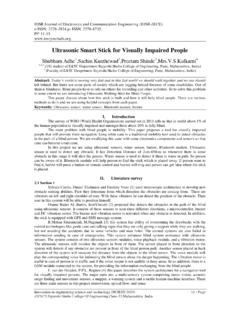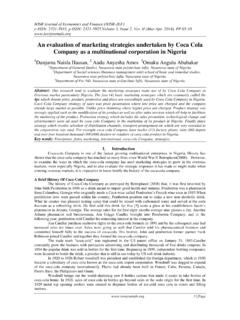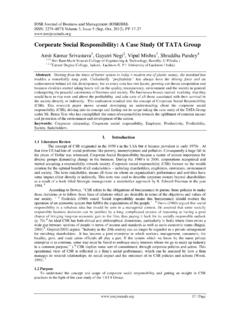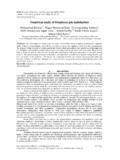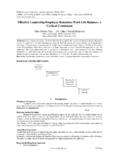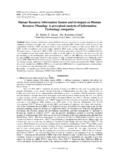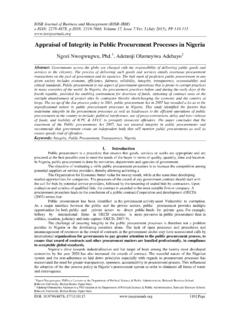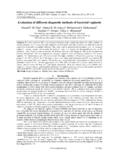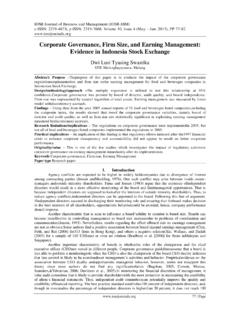Transcription of The Impact of Organizational Structure and Leadership ...
1 IOSR Journal of Business and Management (IOSR-JBM) ISSN: 2278-487X. Volume 6, Issue 6 (Jan. - Feb. 2013), PP 56-63 56 | Page The Impact of Organizational Structure and Leadership Styles on innovation Kenneth Chukwujioke Agbim Business Administration Department, College of Management Sciences, University of agricultural , Makurdi, Nigeria Abstract: Generally, organizations build up their competitive advantage by enlarging and enhancing their idea repository, mainly through formal organisationl Structure . However, this study was designed to bring to the fore the relevance of the informal social relations (like Leadership and relationship styles) in the innovation process.
2 To achieve this objective, the study investigated the link among organic and mechanistic structures, Leadership and relationship styles, and the innovation process through the lens of the knowledge creation theory. Data was collected by means of questionnaires and analysed using regression anaslysis. It was found that: the organic Structure impacts idea generation; mechanistic Structure impacts idea implementation; transformational Leadership impacts idea generation; transactional Leadership impacts idea implementation; relationship styles moderates the Impact of transformational Leadership on idea generation; and relationship styles moderates the Impact of transactional Leadership on idea implementation.
3 This therefore connotes that an organization could be ambidextrous at the same time and within the same department. A manager that is aspiring to develop innovative employees and a competitive organization in a turbulent environment is thus advised to employ both structures and Leadership styles with a good relationship atmosphere among employees within the organization. Keywords: innovation , Leadership styles, Organizational Structure , Relationship styles, Turbulent environment I. Introduction Organizations today are immersed in a competitive and constantly changing environment (Karami, 2008; Oghojafor et al.)
4 , 2011). These changes basically include: changes in products/services; technology and markets. For instance, several products are being reinvented while the advancement in Information, Communication and Technology (ICT) is continuously turning around the way and manner services and/or products are being delivered or produced. Furthermore, increase in corruption with the attendant changes in the status of those involved; incessant occurrence of natural disasters with their attendant death tolls; increase in fertility rate with its incidence of high population rate among other issues are gradually occasioning the rapid changes in markets all over the world.
5 Above all, mention must be made of the consequential effects of the global economic meltdown in the environment of business (Akpotu, 2008; Oki, 2009). This, of course, implies that the aforementioned issues and many more have increased the turbulence in the environment and have further precipitated factors that tend to influence the decisions and operations of organizations. To adapt, change and by extension generate more profit, organizations need to continuously reinvent themselves. One of the ways through which organizations do this is by being innovative. innovation is a critical force in the improvement of Organizational performance and in enhancing economic growth and development.
6 More so, organizations must be innovative to survive and flourish in the competitive and rapidly changing environment. The fact that employees and leaders in an organization are involved in idea generation and implementation makes the incorporation of the concept of Organizational Structure in this study very important. Organizational Structure (organic and mechanistic) is comprised of Leadership styles (transactional and transformational) and relationship style (between the organization and supervisors; the organization and employees; the supervisors and the employees; and among the employees).
7 The interplay of the Leadership and relationship styles can positively or negatively Impact the employees innovativeness. Haven recognized the importance of innovation or knowledge creation in organizations; scholars have tried to find out the exact mechanism for it. Among all, Nonaka and Takeuchi (1995) have developed a theory of Organizational knowledge creation, which have gradually gained significance in the last decade. Nonaka and Takeuchi posit that knowledge creation is the result of the interaction and conversion between two kinds of knowledge, that is, tacit and explicit knowledge.
8 There are four modes of conversion mechanisms in the process of knowledge creation: socialization (from tacit knowledge to tacit knowledge), externalization (from tacit knowledge to explicit knowledge), combination (from explicit knowledge to explicit knowledge), and internalization (from explicit knowledge to tacit knowledge). The Impact of Organizational Structure and Leadership Styles on innovation 57 | Page The conversion of tacit to explicit knowledge is a social process between individuals (Popadiuk and Choo, 2006; Vonkrogh, 1998).
9 Based on a constructionist perspective (Vonkrogh, 1998), Nonaka and Takeuchi (1995) treated knowledge as justified true belief instead of what cognitivists called representation meaning that knowledge is universal. In this study, the view that individuals have to justify the truthfulness of their beliefs through personal sensemaking and individual experience under the interaction between themselves and the social context which they are embedded in is adopted (Vonkrogh, 1998; King and Zeithaml, 2003; Murray and Blackman, 2006). This implies that the innovativeness of individuals/employees in an organization is enhanced by the good relationship and Leadership styles within the organization.
10 Though, Nonaka and Takeuchi (1995) theory of Organizational knowledge creation gives us a clear picture of how knowledge is converted and socialized within Organizational context. Nevertheless, some issues needs to be further investigated. Nonaka and Takeuchi did not categorize knowledge creation ( innovation ) process; the system/ Structure (if any) that facilitates the process was not mentioned; and the Leadership and relationship styles that enhances employees innovativeness were not identified. This study therefore seeks to examine the link among the organic and mechanistic structures, the innovation process, and Leadership and relationship styles.
